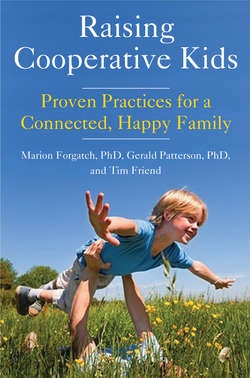Читать книгу Raising Cooperative Kids - Marion S. Forgatch - Страница 11
На сайте Литреса книга снята с продажи.
Chapter One Imagine
ОглавлениеAs parents, we shape our children's behavior from the day they are born. Their behaviors—desirable and undesirable alike—become established as we reinforce them through our own actions, reactions, and inactions. In this chapter, we'll discuss how you can encourage cooperation in your children and help you to become aware of behaviors that may innocently send the wrong messages.
As Jerry studied families in their homes, he developed what has become known as “coercion theory.” Coercion starts out as a vital, natural survival instinct that can be found in infants as well as baby birds. Before children develop language, they communicate their needs to be fed, held, or have their diapers changed by crying. Unattended infants can fly into little fits of apparent rage. It's their only way of telling you that they need something, and they need it now. As they begin to develop language, we have to teach children to ask for what they need. If we don't, that coercive behavior can allow toddlers to control their parents. To see unadulterated coercion in action, watch a three-year-old throw a temper tantrum in a grocery store. See how the parent and child react to each other. Observe the escalation in the intensity of emotions during the exchange. This is a battle of wills between a little kid and a grown-up. Watch how it ends, who wins, and why.
Coercion lies at the root of most of the battles we see between siblings and between parents and children. You can think of coercion as a dark side of human nature inside all of us. Understanding what coercion is and how it interferes with loving relationships can enable you to recognize it when it arises and do something about it. Because coercion is the cause of so much of the trouble between parents and young children, reducing it is a core component of our parenting techniques. When parents learn to reduce coercive actions in their children—and in themselves—cooperative behaviors have a better chance to grow and thrive. When we first become parents, many of us start out with vague dreams for ourselves, our individual children, and our families as a whole. You have probably had some kind of vision of the family you wanted ever since you were a child—though it is rare for anyone to sit down with us when we are young (and most receptive) and explain how to raise a happy family, let alone model how it is done. Your vision, however amorphous it may be, was likely influenced by the strengths and values that determined how you were raised—for better or worse.
Sit back and imagine the family you want. What you imagine is probably different from your partner's ideal family. If one of you had a great childhood, you will surely follow in the footsteps of those amazing parents. If your childhood was rocky, you may be thinking of different ways to raise your children. Unfortunately, many of us are so busy that we don't spend much time planning our parenting strategies. We live in a different world from the one in which we grew up. Raising children is more expensive than ever, employers demand more work, our relationships become loaded with stress, and we sacrifice our dreams to focus on the problems at hand. Now is the time to rekindle your dreams and get ready to create the changes you want for your family. Changing bad habits and teaching new skills require that you think carefully about your goals. We urge you to think big and reach high to create the family you have always wanted.
Dreams can lie dormant and may even die unless you awaken them and imagine ways to make them come true. Once you conceive your dreams, how do you give birth to them? It's easy to say: “I want my children to get along with others or do well in school.” It is quite another thing to say: “Here's how I will make it happen.” You start by setting goals. Begin with something feasible, and then break down the goal into steps using the Goldilocks rule—not too big, not too small, but just right. When you accomplish one goal, set a new one.
For instance, imagine teaching your children to get ready for bed on their own. Our approach is to first show them each tiny step; then we patiently teach them to put the steps together—take a bath, dress for bed, and brush their teeth. Gradually, your children learn to do it all themselves, and you can move on to another set of skills. Setting goals and planning the steps required to reach them is a kind of telescoping process—you look ahead to the future, you zoom back to the present, and you figure out how to get from here to that distant place. With practice, your skill at making long- and short-term goal statements will grow, and you will become a master of making dreams come true.
